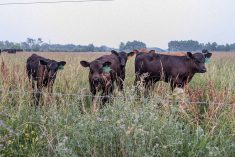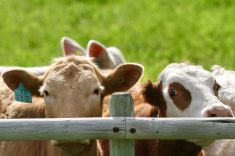Livestock producers used to tell their city cousins that manure doesn’t stink. It smells like money. For many people, that smell is no longer a joking matter.
Rural and urban people have joined forces demanding strict environmental controls on manure storage and spreading so they don’t get a whiff of it every time they step outside.
Yet researchers are finding there are no easy or fail-safe solutions.
Alberta, the livestock giant in Canada, is the centre of some of the research.
Its herds produce 2.3 million tonnes of muck each year – one million tonnes from hog and beef operations and the rest from poultry and dairy farms.
Read Also

U.S. farm group supports supply management
U.S. grassroots farm advocacy group pushing new agriculture legislation that would move towards supply management like Canada has for dairy industry
It is scientifically possible to measure the nuisance factor of manure, especially from swine operations.
“The reality of pig manure is that it stinks,” said Emil Domboski, of the Alberta Research Council.
A 1995 University of Iowa study identified 160 airborne compounds that come from swine production.
Decomposing pig waste is a mixture of feces, urine, skin cells, hair, feed and bedding that produces a chemical soup of sulfides, ammonia, organic acids and alcohols, as well as gases like carbon dioxide, hydrogen sulfide and methane.
Masking the smell
The research council at Vegreville is measuring odor and looking for ways to control it.
There are a number of odor-control tests under way but so far, no system has been declared a clear winner. No system has proven itself on a large scale.
Through the wonders of modern science, mechanical systems that simulate the human nose have been developed to measure the strength and amount of an odor. It provides scientific measurement of what the human nose picks up as stink.
Other research involves a bio-filtration system that breaks down the smells of hydrogen sulphide and ammonia found in feces and urine.
Composting wastes is an option for some operations. Another experiment involves snowfluent.
Waste is frozen into pellets and sprayed onto a field similar to a snow making machine used on ski hills. The pellets melt in spring, the water runs away and the solids are left on the ground as nutrients.
Farmers are pitching in with their own attempts to reduce the problem, said Alberta Agriculture waste management specialist Brian West.
To reduce surface disturbance, clay lined lagoons are filled from the bottom. Some have tried covering lagoons with straw or plastic to mask odor. Most commonly however, odor is diluted by distance from neighbors.
West helped write the Alberta code of manure management and now recognizes the formulas in the code for distance separation may not be adequate for larger operations. The code likely will be revised in the next year to deal with larger farms, he said.
“I think there are some practical limits on how big each unit goes,” said West.
Manure application is one of the limits. Pig manure is 96 percent water and farmers don’t want to haul it more than a few kilometres because it’s costly.
At the same time, farmers need information on how much manure can go onto a plot of land. Researchers, concerned about overloading the land with nitrogen, potash, potassium and phosphorus, are devising sustainable application rates.
Considerations to be made
Once upon a time, planning a hog operation expansion was relatively simple.
Is feed, land and good genetic stock available? Is there a buck to be made?
Now, University of Saskatchewan waste management specialist Ernie Barber says health and environmental concerns are as important as economics.
As industry leaders dream of prairie expansion, Barber suggests a checklist of issues to be considered before the first load of concrete is poured.
- How far is the proposed farm from settlement and how will manure be managed?
- Will the high profit potential attract absentee landlords who may not monitor the farm’s waste management properly?
- Is a 2,000-sow operation still a farm by traditional definition?
- Will larger farms relying on hired help fit into the community as well as did traditional family farms?
- Does the local government have adequate regulations to control an expanding hog sector?
- What plans are in place to deal with worker health and safety?
- How will abandoned sites be handled? Who will clean it up?
- How will these operations affect land values, water and air quality?















